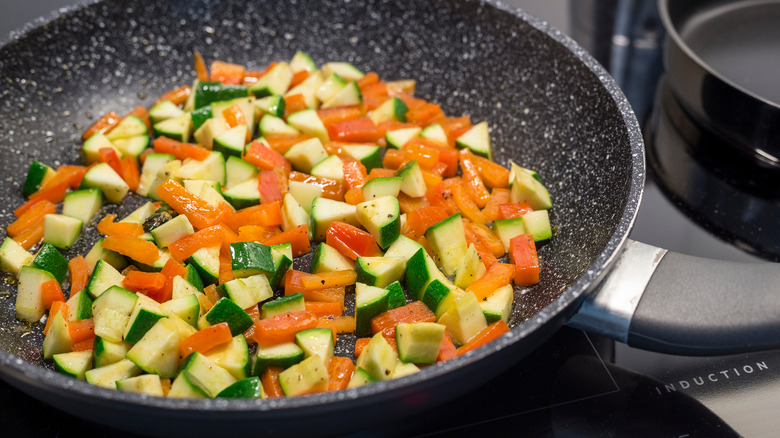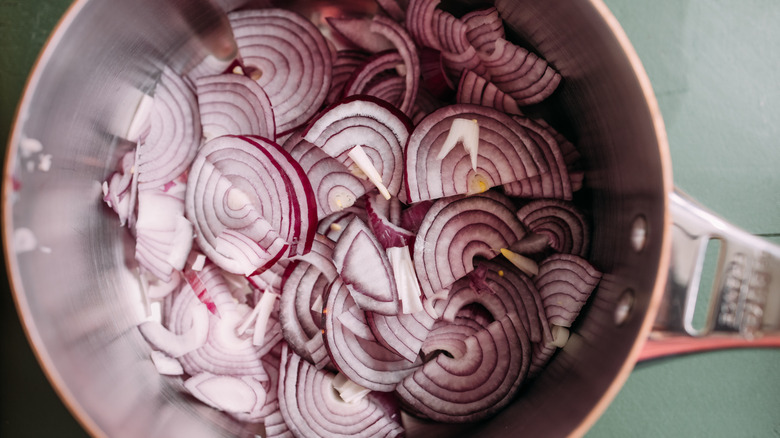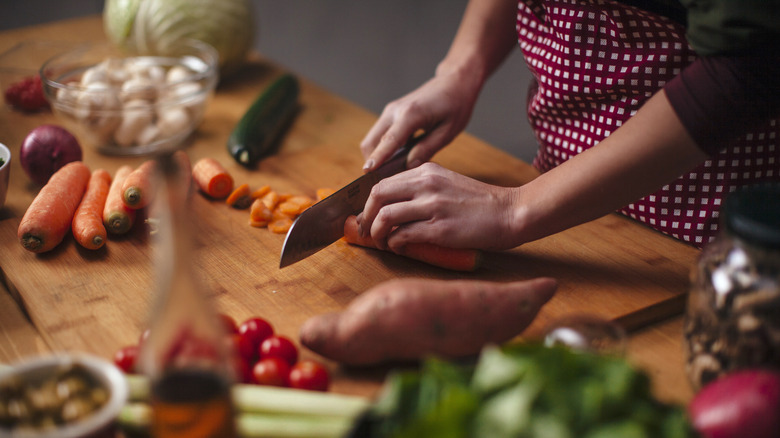The All-Important 'Ground-Up' Rule For Sauteing Vegetables
If you're sautéing up a mix of vegetables, you'll want to think carefully about the order you add vegetables to the pan — and you don't want to throw them all in the pan at once. It might be annoying to mentally bookmark the cooking time needed for every vegetable you could potentially sauté, but there's a trick to knowing the correct order to put them in the pan.
Basically, you want to add the vegetables from the "ground up." That means starting with veggies that grow in the ground and working your way up to the above-ground produce. You'll start with root vegetables like potatoes and carrots, which need the most time to cook through — as long as 15 minutes. Next, you'll move on to the heavier produce that grows above ground, like broccoli and cauliflower. Remember these because they are veggies that grow very close to the ground; they take up to 10 minutes to cook. Lighter, above-ground produce comes next. Green beans, for example, might need only five to eight minutes. Anything leafy (think of these as coming from the top of a tree), like spinach, or an herb like basil should go right at the end, where it might cook for only a minute or two.
The ground up rule has a few catches
The "ground up" rule is great as a general guide for sautéing vegetables, but bear in mind that there can be nuances and exceptions. For example, onions and aromatics, like shallots or ginger, are mostly below-ground produce but are known to cook faster than other below-ground veggies, like sweet potatoes or carrots. But despite this, you may want to start cooking them first so that they add lots of flavor to the dish.
Some vegetables don't perfectly suit the rule. For example, you might think mushrooms would fit alongside broccoli since they grow close to the ground; they have a pretty fast sauté time and could probably be added later (but still before more delicate additions like leafy greens). Bell peppers are also a bit flexible with the rule: The general tip is to add them around the same time you'd add broccoli and cauliflower, but some recipes suggest throwing them in early, alongside the onions, to impart more flavor. The same goes for chiles. If you want a little crunch, you could add them on the later side. In any case, bell peppers are less likely to get super overcooked and mushy, so adding them early isn't a huge issue.
Other rules and tips for a perfect vegetable sauté
The ground up rule isn't the only thing you need to know to ensure your vegetables turn out well; apply these other strategies to avoid common sautéing mistakes. First, no matter what you're sautéing, make sure it's chopped as uniformly as possible. This helps all the pieces cook in approximately the same amount of time. Depending on your knife skills, this might be easier to accomplish when dicing a rutabaga, where you can probably get nice, even ½-inch cubes versus something with oddly-shaped florets like broccoli, but do your best.
Secondly, if you're working with many veggies, be ready to do some mental math. For example, if you think your potatoes need 15 minutes to sauté, remember they won't be in the pan alone the entire time. If you're using cauliflower, which might need 10 minutes to cook, add it around seven minutes after the potatoes. You don't need to follow the recommended cooking times down to the second: Sautéing speeds can vary. For example, a crowded pan will cook more slowly. If you are unsure how thoroughly something has cooked, taste a veggie piece from the pan. It's also worth considering par-boiling (partially cooking something in boiling water) root vegetables before sautéing to speed up the process.


